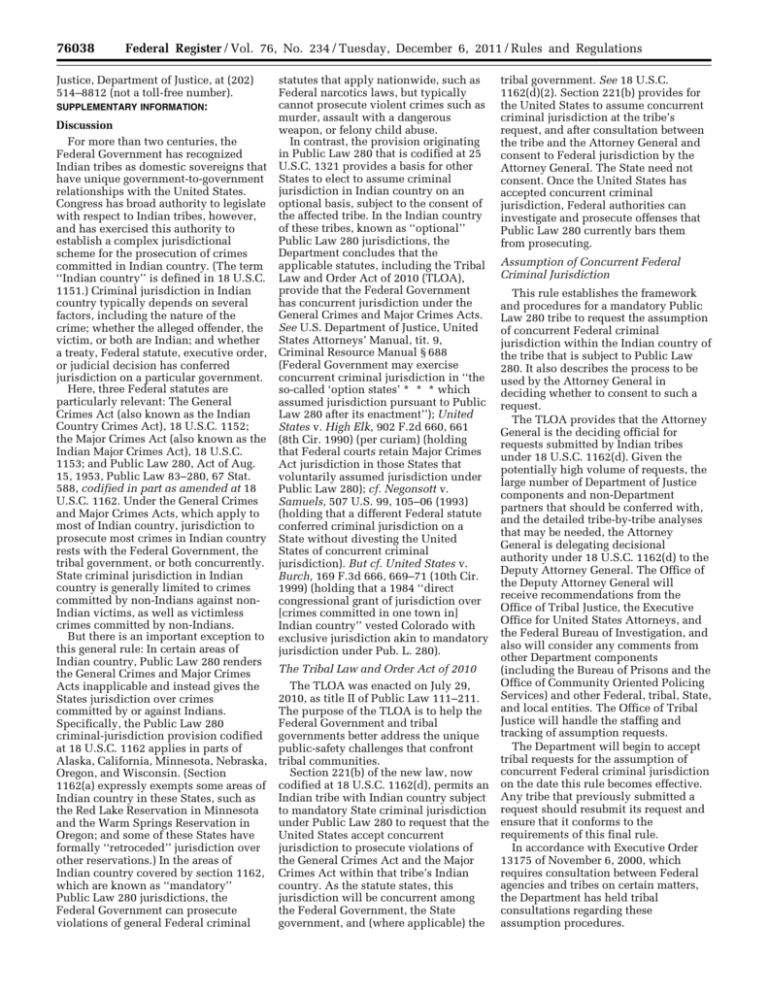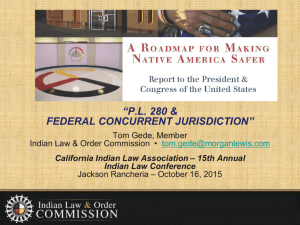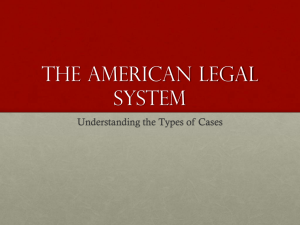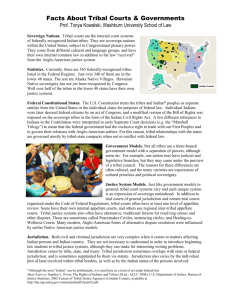Federal Register/Vol. 76, No. 234/Tuesday, December 6, 2011
advertisement

76038 Federal Register / Vol. 76, No. 234 / Tuesday, December 6, 2011 / Rules and Regulations tkelley on DSK3SPTVN1PROD with RULES Justice, Department of Justice, at (202) 514–8812 (not a toll-free number). SUPPLEMENTARY INFORMATION: Discussion For more than two centuries, the Federal Government has recognized Indian tribes as domestic sovereigns that have unique government-to-government relationships with the United States. Congress has broad authority to legislate with respect to Indian tribes, however, and has exercised this authority to establish a complex jurisdictional scheme for the prosecution of crimes committed in Indian country. (The term ‘‘Indian country’’ is defined in 18 U.S.C. 1151.) Criminal jurisdiction in Indian country typically depends on several factors, including the nature of the crime; whether the alleged offender, the victim, or both are Indian; and whether a treaty, Federal statute, executive order, or judicial decision has conferred jurisdiction on a particular government. Here, three Federal statutes are particularly relevant: The General Crimes Act (also known as the Indian Country Crimes Act), 18 U.S.C. 1152; the Major Crimes Act (also known as the Indian Major Crimes Act), 18 U.S.C. 1153; and Public Law 280, Act of Aug. 15, 1953, Public Law 83–280, 67 Stat. 588, codified in part as amended at 18 U.S.C. 1162. Under the General Crimes and Major Crimes Acts, which apply to most of Indian country, jurisdiction to prosecute most crimes in Indian country rests with the Federal Government, the tribal government, or both concurrently. State criminal jurisdiction in Indian country is generally limited to crimes committed by non-Indians against nonIndian victims, as well as victimless crimes committed by non-Indians. But there is an important exception to this general rule: In certain areas of Indian country, Public Law 280 renders the General Crimes and Major Crimes Acts inapplicable and instead gives the States jurisdiction over crimes committed by or against Indians. Specifically, the Public Law 280 criminal-jurisdiction provision codified at 18 U.S.C. 1162 applies in parts of Alaska, California, Minnesota, Nebraska, Oregon, and Wisconsin. (Section 1162(a) expressly exempts some areas of Indian country in these States, such as the Red Lake Reservation in Minnesota and the Warm Springs Reservation in Oregon; and some of these States have formally ‘‘retroceded’’ jurisdiction over other reservations.) In the areas of Indian country covered by section 1162, which are known as ‘‘mandatory’’ Public Law 280 jurisdictions, the Federal Government can prosecute violations of general Federal criminal VerDate Mar<15>2010 15:05 Dec 05, 2011 Jkt 226001 statutes that apply nationwide, such as Federal narcotics laws, but typically cannot prosecute violent crimes such as murder, assault with a dangerous weapon, or felony child abuse. In contrast, the provision originating in Public Law 280 that is codified at 25 U.S.C. 1321 provides a basis for other States to elect to assume criminal jurisdiction in Indian country on an optional basis, subject to the consent of the affected tribe. In the Indian country of these tribes, known as ‘‘optional’’ Public Law 280 jurisdictions, the Department concludes that the applicable statutes, including the Tribal Law and Order Act of 2010 (TLOA), provide that the Federal Government has concurrent jurisdiction under the General Crimes and Major Crimes Acts. See U.S. Department of Justice, United States Attorneys’ Manual, tit. 9, Criminal Resource Manual § 688 (Federal Government may exercise concurrent criminal jurisdiction in ‘‘the so-called ‘option states’ * * * which assumed jurisdiction pursuant to Public Law 280 after its enactment’’); United States v. High Elk, 902 F.2d 660, 661 (8th Cir. 1990) (per curiam) (holding that Federal courts retain Major Crimes Act jurisdiction in those States that voluntarily assumed jurisdiction under Public Law 280); cf. Negonsott v. Samuels, 507 U.S. 99, 105–06 (1993) (holding that a different Federal statute conferred criminal jurisdiction on a State without divesting the United States of concurrent criminal jurisdiction). But cf. United States v. Burch, 169 F.3d 666, 669–71 (10th Cir. 1999) (holding that a 1984 ‘‘direct congressional grant of jurisdiction over [crimes committed in one town in] Indian country’’ vested Colorado with exclusive jurisdiction akin to mandatory jurisdiction under Pub. L. 280). The Tribal Law and Order Act of 2010 The TLOA was enacted on July 29, 2010, as title II of Public Law 111–211. The purpose of the TLOA is to help the Federal Government and tribal governments better address the unique public-safety challenges that confront tribal communities. Section 221(b) of the new law, now codified at 18 U.S.C. 1162(d), permits an Indian tribe with Indian country subject to mandatory State criminal jurisdiction under Public Law 280 to request that the United States accept concurrent jurisdiction to prosecute violations of the General Crimes Act and the Major Crimes Act within that tribe’s Indian country. As the statute states, this jurisdiction will be concurrent among the Federal Government, the State government, and (where applicable) the PO 00000 Frm 00012 Fmt 4700 Sfmt 4700 tribal government. See 18 U.S.C. 1162(d)(2). Section 221(b) provides for the United States to assume concurrent criminal jurisdiction at the tribe’s request, and after consultation between the tribe and the Attorney General and consent to Federal jurisdiction by the Attorney General. The State need not consent. Once the United States has accepted concurrent criminal jurisdiction, Federal authorities can investigate and prosecute offenses that Public Law 280 currently bars them from prosecuting. Assumption of Concurrent Federal Criminal Jurisdiction This rule establishes the framework and procedures for a mandatory Public Law 280 tribe to request the assumption of concurrent Federal criminal jurisdiction within the Indian country of the tribe that is subject to Public Law 280. It also describes the process to be used by the Attorney General in deciding whether to consent to such a request. The TLOA provides that the Attorney General is the deciding official for requests submitted by Indian tribes under 18 U.S.C. 1162(d). Given the potentially high volume of requests, the large number of Department of Justice components and non-Department partners that should be conferred with, and the detailed tribe-by-tribe analyses that may be needed, the Attorney General is delegating decisional authority under 18 U.S.C. 1162(d) to the Deputy Attorney General. The Office of the Deputy Attorney General will receive recommendations from the Office of Tribal Justice, the Executive Office for United States Attorneys, and the Federal Bureau of Investigation, and also will consider any comments from other Department components (including the Bureau of Prisons and the Office of Community Oriented Policing Services) and other Federal, tribal, State, and local entities. The Office of Tribal Justice will handle the staffing and tracking of assumption requests. The Department will begin to accept tribal requests for the assumption of concurrent Federal criminal jurisdiction on the date this rule becomes effective. Any tribe that previously submitted a request should resubmit its request and ensure that it conforms to the requirements of this final rule. In accordance with Executive Order 13175 of November 6, 2000, which requires consultation between Federal agencies and tribes on certain matters, the Department has held tribal consultations regarding these assumption procedures. E:\FR\FM\06DER1.SGM 06DER1







